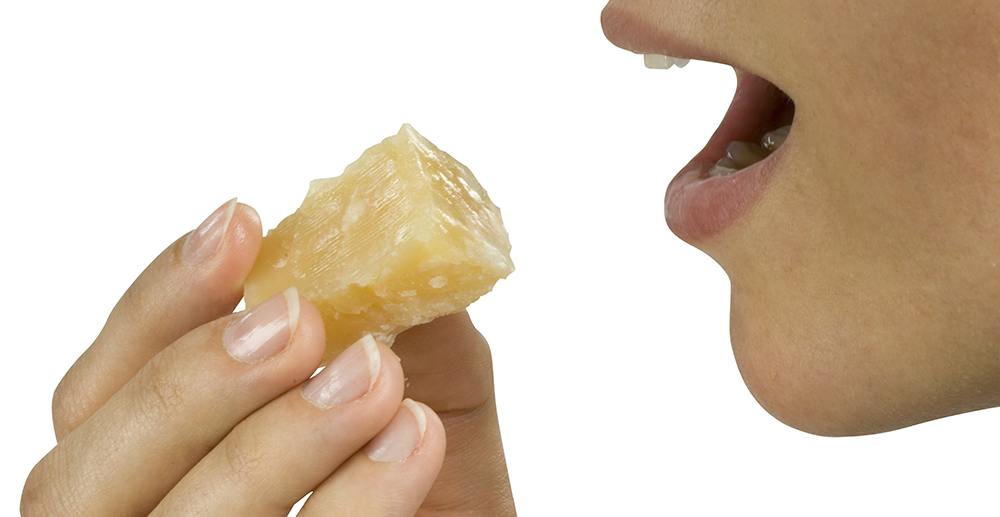
Sensory analysis is the whole of methods and techniques, which allow us to measure, using sensory organs, the quality of a food product or the quality of a drink.
Furthermore it is an analysis conducted in a rigorous and impartial manner by means of human sensory perception. This kind of test is conducted by a panel of adequately learned referees, that will analyse the product in an environment without smells and noises, but with an appropriate brightness.
Thanks to its scientific strictness, the sensory analysis is different from the tasting, which can be conducted also by the consumers that are more or less experts of the product.
The analysis of the appearance, of the taste and of the solidity are important in order to understand the peculiarities of Parmigiano Reggiano and in order to discover combinations of flavours and to taste it all the way. In fact knowing these features allows us to identify the real Parmigiano Reggiano PDO, distinguishing it from products with inferior quality.
The instruments, which are used, are the five senses: sight, hearing, sense of smell, taste and touch. Every organ has specific sensorial perceptors which cause different signals. In fact the factors of a food are numerous and they are able to provoke sensorial incitements, sending clear reactions to the brain.
Sight
The exterior appearance is a relevant feature, also in quality controls. The first quality to consider is the colour of cheese’s paste, that can go from straw-yellow to intense straw-yellow and it can show different degrees of homogeneity. Moreover the colour dipends on different factors and they are cows’ feeding, maturing and preservation process. The visual test takes into analysis both outside (form-crust) and inside (paste) of cheese, measuring the homogeneity’s degree and imperfections.
Also temperature, darkness, roughness, elasticity and greasiness of paste are evaluated apart from the “occhiatura” (little holes in the paste that should be inferior than 2 millimeters of diameter) and the tyrosine crystals, in other words they are white small spots on the surface of the paste, indicators of maturing.
Taste
It is necessary to underline that it is wrong to use the term “taste” as a synonym of “scent”. In fact tastes are only four: sweet, salty, sour and bitter, and so it is wrong to affirm that a cheese “exhibits the intense taste of butter” because the perception of butter is actually a scent.
In this phase of analysis you can evaluate basic flavours and presence or absence of oral feelings such as spicy and astringent.
Mainly a sweet flavour characterises the youngest cheeses, while a salty flavour increases with its maturing.
A specific attention is given to final feelings of aftertaste and to the persistence, which complete the tasting.
The aftertaste specifically concerns the feelings, scents and flavours that remain after that cheese has been swallowed; on the contrary its persistence in time is the permanence of sense of smell-gustative perceptions and its duration is measured in seconds.
Sense of smell
The sense of smell test in generally requires most experience because it is more difficult to be able to understand determined shades. In fact it is possible to pick out the smells’ families (lactic, vegetable, floral, toasted, ect.) and other spices as nutmeg and pepper; in general the strength of smell increases with the maturing.
Hearing
Also the hearing is a criterion of evaluation during a tasting, in fact this sense allows to distinguish some features such as how much it is crisp and its friability.
Touch
Touching Parmigiano Reggiano allows us to confirm paste’s compactness and so to comprehend if it concerns a young, matured or “stravecchio” cheese. The factors, which have to be evaluated, are elasticity, hardness, granularity, friability (the aptitude of the cheese to create flakes during the split) and solubility (in other words the feeling that cheese melts in your mouth).
Even more you know a product, even more you may have an idea of its features and how it should be a standard product. All these structural features are highlighted with the development of the maturing of Parmigiano Reggiano.
The training of devoted subjects to sensory analysis allows us to understand features and scents identifying them based on specific reference products. In order to evaluate for example solubility, you can try a meringue, paying attention to the speed with which it melts in your mouth: this feeling can be compared with the perceived feeling, while you taste cheese.
Here you have the perceivable sensory features that you may have, while you are trying Parmigiano Reggiano, and its relative reference products are: procedure, butter, yogurt, nuts and hazels, Mou toffees, meat soup, table salt, sugar, raw carrot, Wiener sausage, crackers, albumen of boiled egg, meringue.
The identification of precise reference products allows to the tasters to accord on the terms to use in the description.
Here you have the order, which is followed, during the tasting of Parmigiano Reggiano: visual and tactile test (form and paste), sense of smell test (smells and scents), gustative test and the test of its structure.
Between the tasting of two products, it is essential to remove any feeling, for example spacing the tastings with neutralized food such as water, apple, breadsticks, etc.

